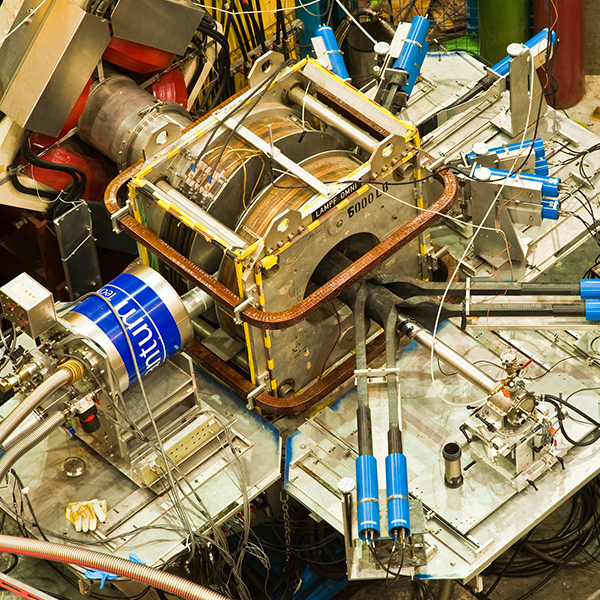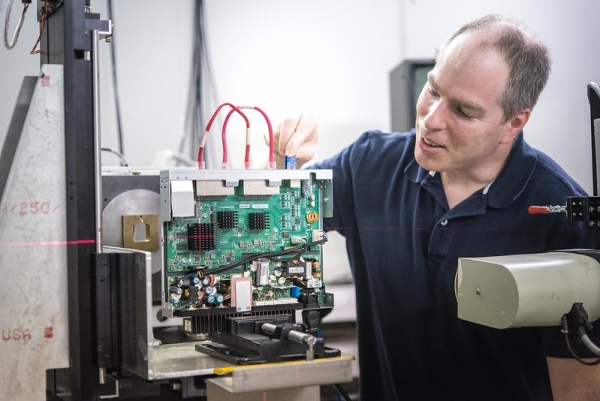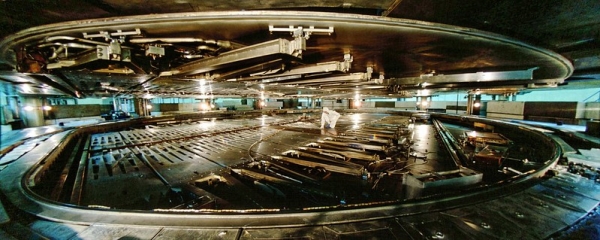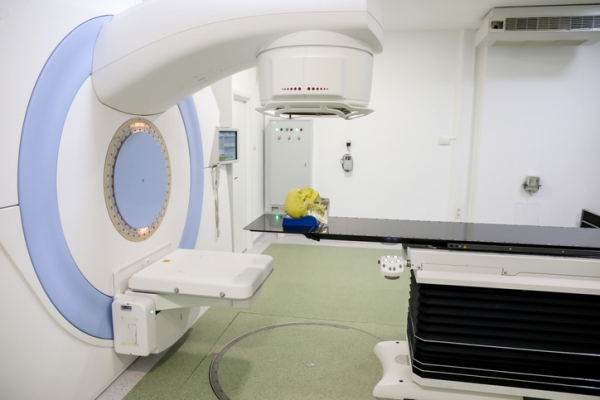Exploring Canada’s Particle Accelerators

Beamline Assembly at TRIUMF (TRIMPF, flickr)

Beamline Assembly at TRIUMF (TRIMPF, flickr)
How does this align with my curriculum?
| Grade | Course | Topic |
|---|
Particle accelerators have amazing applications - from growing food to making airplanes safe.
You wouldn’t know it from above ground, but there are particle accelerators deep inside basements across the country. Particle accelerators may sound like sci-fi, but their real life applications are already here. Their innovative work is accelerating Canada forward.
What is a particle accelerator?
A particle accelerator is a machine that propels charged particles. The charged particles may include electrons, protons, or ions. The accelerator propels the particles at close to the speed of light. This is done using electromagnetic forces that are generated inside the accelerator. Electromagnetic forces include the electric fields that accelerate the particles and the magnetic fields that steer them.
The function of an accelerator determines its size and shape. The larger it is, the faster it can accelerate particles. This allows researchers to do many different types of experiments. But large accelerators are very expensive. Sometimes small particle accelerators are all that’s needed.
Testing the Effects of Radiation on Airplanes
There’s no better place to start our journey into Canada’s particle accelerators than at TRIUMF. This is Canada’s national particle accelerator centre in Vancouver, British Columbia. Scientists at TRIUMF focus on particle physics and nuclear physics. Their work has applications in many fields, including aviation.

PIF & NIF are TRIUMF’s proton- and neutron-irradiation facilities. Here, scientists use intense beams of protons and neutrons to simulate weeks, months, or years spent in specific radioactive environments.
We are constantly bombarded with radiation from galactic cosmic rays, solar energetic particles and the Earth’s radiation belts. This radiation becomes more intense as you leave Earth’s surface. This is because there is less atmosphere to protect you. For example, radiation can be almost 600 times more intense on an aircraft at cruising altitude, than on the ground.
This can have a big impact on equipment. It can reduce the efficiency of computer chips for example. So, companies like Boeing and Cisco Systems bring their avionics, microelectronics and communications equipment to TRIUMF. There it is bombarded by beams of neutrons from a cyclotron particle accelerator. This allows scientists to test the long-term effects of radiation on the equipment.

Helping Crops Withstand Climate Change
Canadian Light Source (CLS) in Saskatoon, Saskatchewan uses a different type of particle accelerator: a synchrotron. Inside a synchrotron, electrons are accelerated by radio frequency waves. Magnets push on these electrons to produce brilliant, highly-focused light. This light is directed towards small laboratories. There, researchers observe interactions between the light and different materials.
One researcher at CLS is Na Liu. Liu studies the impact of climate change on agriculture. As our climate changes, farmers and scientists will need to change how they work. This will be necessary in order to keep growing the same amount of food. Liu is learning how environmental stress affects plants. This will help farmers know what to expect.
Liu studies a plant called Arabidopsis. Different Arabidopsis plants were grown in different conditions. Some had limited water to simulate drought. Liu studied the leaves on these plants using the light from the CLS. This allowed Liu to see how normal plants were different than those with drought stress.

The advantage of using light from the CLS is that scientists can learn about the structural and chemical properties of materials at the molecular level. They can do this quickly, without damaging them.
Using Radiation to Treat Cancer
Sometimes damage is exactly what scientists are looking for. The Grand River Regional Cancer Centre in Waterloo, Ontario is one of many Canadian hospitals that use particle accelerators in external radiation therapy.
Small linear accelerators (LINAC) inside the hospital are used to produce radiation that destroys cancer cells. The LINAC produces high-energy electrons that collide with a heavy metal target. This produces high-energy x-rays that conform to the shape of the patient’s tumour. A medical physicist aims these rays at a tumour to stop its growth and kill its cells. This treatment leaves the normal (non-cancerous) tissue around the tumour undamaged.

Producing Lifesaving Particles Locally
Eastern Health in St. John’s, Newfoundland and Labrador began using a new cyclotron in 2020. This produces medical radioisotopes for diagnosis and imaging.
Did you know?
An isotope is a version of an atom that has a different number of neutrons than normal. A radioisotope is an unstable isotope. These have excess neutrons or energy that can change into other elements over time.
Cyclotrons produce radioisotopes by colliding particle beams with targets. This collision transforms one atom into another through the loss of neutrons.
For example, bombarding molybdenum-100 (element with 100 neutrons) with photons produces molybdenum-99 (with only 99 neutrons). This powerful new isotope is very unstable. When molybdenum-99 decays further and loses a proton, it becomes technetium-99m. Technetium-99m is used in over 5 500 medical scans every day in Canada.
The ability to produce medical radioisotopes locally saves time and lives. Most hospitals depend on a handful of nuclear reactors for their medical radioisotopes. This is unreliable. If something goes wrong, there could be a sudden, serious shortage.
Particle accelerators are a more reliable and efficient way to produce medical radioisotopes. Scientists are now trying to design smaller, cheaper accelerators that are easier to use in hospitals. This means that doctors could use medical radioisotopes immediately, to perform life saving procedures.
Canada’s impact around the world
Canadian particle accelerators also contribute to the international physics community. Scientists here continue to make major contributions to CERN. CERN is a particle physics centre in Geneva, Switzerland. It houses the world’s largest particle accelerator, called the Large Hadron Collider (LHC).
The LHC is famous for its discovery of the Higgs boson - nicknamed the “God particle”. Scientists had theorized that this mysterious particle existed. But no one saw it until July 4 2012 when the ATLAS experiment detected the particle.
The ATLAS detector is one of the largest and most complex scientific instruments ever constructed. Its detectors allow researchers to study the behavior of particles, whether on their own or during collisions. But these detectors are so massive that international collaborators are needed. Scientists around the world helped to build them and track the data they produced.
Researchers across Canada contributed to the design, machining, assembly and construction of the ATLAS detector. Canada is also part of the Worldwide LHC Computing Grid. TRIUMF hosts one of nine international Tier-1 Data Centres where scientists collect and process data from the ATLAS detector.
Particle accelerators are key to understanding the physical world improving human health and safety. These Canadian accelerators are just a few examples of the spectacular impact of these machines on our lives.
Starting Points
- Which particle accelerator is closest to where you live?
- Do you know someone who has had radiation therapy? What was it for?
- Why is it important to have particle accelerators, such as a cyclotron, in various locations across Canada?
- What are the benefits of funding research in the field of particle science?
- How has Canadian science and technology contributed to particle science discoveries?
- What is a particle accelerator?
- How does a cyclotron produce radioisotopes?
- How has the Large Hadron Collider (LHC) contributed to the field of particle science?
- What makes linear accelerators (LINAC) useful for treating various forms of cancer?
- How are projects like the Large Hadron Collider (LHC) and the Atlas project impacting collaboration in science?
- How is the dynamic nature of science being demonstrated in the field of particle science?
- What recent news can you find in the media about particle science? Describe.
- Do you think many people in Canada know about the particle accelerators in Canada and how they contribute to science and society? How would you promote this aspect of Canadian science and technology to the general population?
- This article supports teaching and learning in Physics, Technology & Engineering, Health, Environmental Science related to electric fields, magnetic fields, modern physics, particle physics, agriculture, cancer, radiation and medical imaging. Concepts introduced include particle accelerator, synchrotron, linear accelerators, cyclotron, diagnosis, imaging, isotope, neutrons, radioisotopes, photons, and technetium-99.
- Before reading this article, teachers could have students use a Vocabulary Preview learning strategy to engage prior knowledge and introduce new vocabulary. Ready-to-use Vocabulary Preview reproducibles for this article are available in [Google Doc] and [PDF] formats.
- To consolidate learning during or after reading the article, teachers could have students complete a Concept Definition Web learning strategy for the concept particle accelerator. Ready-to-use Concept Definition Web reproducibles for this article are available in [Google Doc] and [PDF] formats.
- To go further, teachers could have students consider the value of having Canada invest in particle accelerator technology by using a Think-Discuss-Decide learning strategy to respond to the statement, “Global collaboration in science and technology means that Canada has no need to invest in its own particle accelerator technology.” Ready-to-use Think-Discuss-Decide reproducibles for this article are available in [Google Doc] and [PDF] formats.
Connecting and Relating
- Which particle accelerator is closest to where you live?
- Do you know someone who has had radiation therapy? What was it for?
Relating Science and Technology to Society and the Environment
- Why is it important to have particle accelerators, such as a cyclotron, in various locations across Canada?
- What are the benefits of funding research in the field of particle science?
- How has Canadian science and technology contributed to particle science discoveries?
Exploring Concepts
- What is a particle accelerator?
- How does a cyclotron produce radioisotopes?
- How has the Large Hadron Collider (LHC) contributed to the field of particle science?
- What makes linear accelerators (LINAC) useful for treating various forms of cancer?
Nature of Science/Nature of Technology
- How are projects like the Large Hadron Collider (LHC) and the Atlas project impacting collaboration in science?
- How is the dynamic nature of science being demonstrated in the field of particle science?
Media Literacy
- What recent news can you find in the media about particle science? Describe.
- Do you think many people in Canada know about the particle accelerators in Canada and how they contribute to science and society? How would you promote this aspect of Canadian science and technology to the general population?
Teaching Suggestions
- This article supports teaching and learning in Physics, Technology & Engineering, Health, Environmental Science related to electric fields, magnetic fields, modern physics, particle physics, agriculture, cancer, radiation and medical imaging. Concepts introduced include particle accelerator, synchrotron, linear accelerators, cyclotron, diagnosis, imaging, isotope, neutrons, radioisotopes, photons, and technetium-99.
- Before reading this article, teachers could have students use a Vocabulary Preview learning strategy to engage prior knowledge and introduce new vocabulary. Ready-to-use Vocabulary Preview reproducibles for this article are available in [Google Doc] and [PDF] formats.
- To consolidate learning during or after reading the article, teachers could have students complete a Concept Definition Web learning strategy for the concept particle accelerator. Ready-to-use Concept Definition Web reproducibles for this article are available in [Google Doc] and [PDF] formats.
- To go further, teachers could have students consider the value of having Canada invest in particle accelerator technology by using a Think-Discuss-Decide learning strategy to respond to the statement, “Global collaboration in science and technology means that Canada has no need to invest in its own particle accelerator technology.” Ready-to-use Think-Discuss-Decide reproducibles for this article are available in [Google Doc] and [PDF] formats.
Learn more
How Particle Accelerators Work. (2014)
This Energy.gov article with infographics illustrates how scientists use particle accelerators to study the subatomic world.
Inside the World’s Largest Particle Accelerator (2016)
This video from Discovery News includes video of the experiments along the Large Hadron Collider and interviews with the scientists who run them.
This page on the CERN website uses infographics to explain how scientists discovered the Higgs boson particle. (6:13 min)
This article from the Canadian Cancer Society provides information for patients on different external radiation therapy treatments.
Inside the World’s Largest Cyclotron (2019)
This video from Linus Tech Tips is a tour of the TRIUMF facility and an overview of the work being done there.
360° tour: ATLAS Experiment - Inside CERN's largest detector! (2020)
This 360 video tour of the Atlas experiment allows you to virtually visit the particle accelerator.
References
Canadian Cancer Society. (n.d.). External radiation therapy.
Canadian Nuclear Safety Commission. (2020). Particle accelerator facilities.
CBC News. (2016, November 28). Cancer-detecting cyclotron installed at Health Sciences Centre in St. John's.
CERN. (2020). Atlas.
CERN. (n.d.). Accelerators.
CERN. (n.d.). The Higgs boson.
Dotson, B. (2014). How particle accelerators work. U.S. Department of Energy.
Grand River Hospital. (2017, April 30). New treatment equipment to begin serving cancer patients on May 1st.
Hoehr, C., Bénard, F., Buckley, K., et al. (2017). Medical isotope production at TRIUMF – From imaging to treatment. Physics Procedia, 90, 200-208. DOI: 10.1016/j.phpro.2017.09.059
Liu, N., Zhao, L., Tang, L., et al. (2020). Mid‐infrared spectroscopy is a fast screening method for selecting Arabidopsis genotypes with altered leaf cuticular wax. Plant Cell Environ, 43, 662–674. DOI: 10.1111/pce.13691
Lougheed, T. (2013). Cyclotron production of medical isotopes scales up. CMAJ, 186(11), 947. DOI 10.1503/cmaj.109-4525
Matthews, E. (2020, March 13). Helping crops to withstand drought and climate change. Canadian Light Source.
Merminga, L. (2014). A career in accelerator physics. TRIUMF.
Meyer, T. I. (2012, July 10). How the Higgs did we get here? TRIUMF.
Canadian Light Source. (n.d.). Mid infrared spectromicroscopy (mid-IR) 01B1-1.
Radiologyinfo.org. (2019). Linear accelerator.
TRIUMF. (2011, January 18). FAQ on medical isotopes and cyclotrons.
TRIUMF. (2010, August 25). Neutron irradiation facilities (NIF) overview.
TRIUMF. (2010, August 25). PIF & NIF.
VOCM. (2020, February 22). Eastern Health receives licence to begin commissioning of cyclotron.